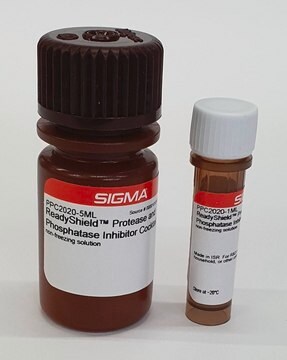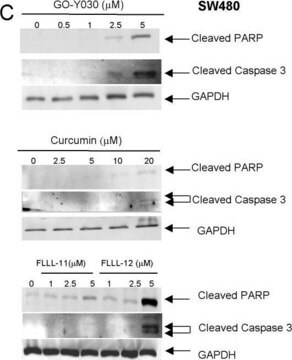MSSAFE
MS-SAFE Protease and Phosphatase Inhibitor
Synonym(s):
Mass Spectrometry Safe Protease and Phosphatase Inhibitor Cocktail
Sign Into View Organizational & Contract Pricing
All Photos(1)
About This Item
UNSPSC Code:
12352200
NACRES:
NA.77
Recommended Products
General description
Mass spectrometry (MS) compatible protease inhibitor cocktail and phosphatase inhibitor cocktail, with broad specificity for the inhibition of:
- Serine, cysteine and aspartic proteases, and metalloproteases
- Tyrosine, serine/threonine, acid and alkaline phosphatases
Specificity
Protease inhibitors: serine, cysteine and aspartic proteases, and metalloproteases
Phosphatase inhibitors: tyrosine, serine/threonine, acid and alkaline phosphatases
Phosphatase inhibitors: tyrosine, serine/threonine, acid and alkaline phosphatases
Application
MS-SAFE Protease and Phosphatase Inhibitor has been used to measure ribosomal protein S6 kinase (S6K) activity.
Tested in mammalian cell lysates and liver tissue extracts. Designed for use in samples to be analyzed by mass spectrometry.
Features and Benefits
Comprehensive protease and phosphatase inhibitor cocktail for mass spectrometry analysis
Compatible with downstream sample processing such as His-tagged protein purification and phosphopeptide enrichment
Allows accurate measurement of protein activity and identification of phosphorylation sites.
Compatible with downstream sample processing such as His-tagged protein purification and phosphopeptide enrichment
Allows accurate measurement of protein activity and identification of phosphorylation sites.
Components
Protease inhibitors:
- Bestatin hydrochloride
- Leupeptin
- Phosphoramidon disodium salt
- Pepstatin A
- Elastatinal
- Aprotinin
- Nafamostat mesylate
- Antipain
- Okadaic acid
- Sodium fluoride
- Sodium orthovanadate
- Bromotetramisole oxalate
- β-lactose
- DL-leucine
Quantity
One vial makes 20 mL of 1× inhibitor cocktail working solution, using either water or extraction/lysis buffer. Alternatively, a 10× concentrated solution may be prepared by adding 2 mL of water or extraction/lysis buffer. This 10× solution may then be diluted 10-fold into extraction/lysis buffer as needed for a 1× working solution.
Physical form
Lyophilized powder that is water-soluble
Signal Word
Warning
Hazard Statements
Precautionary Statements
Hazard Classifications
Acute Tox. 4 Oral - Eye Irrit. 2 - Skin Irrit. 2
Storage Class Code
11 - Combustible Solids
WGK
WGK 3
Flash Point(F)
Not applicable
Flash Point(C)
Not applicable
Certificates of Analysis (COA)
Search for Certificates of Analysis (COA) by entering the products Lot/Batch Number. Lot and Batch Numbers can be found on a product’s label following the words ‘Lot’ or ‘Batch’.
Already Own This Product?
Find documentation for the products that you have recently purchased in the Document Library.
Customers Also Viewed
Mark D Schuchard et al.
BioTechniques, 39(2), 239-247 (2005-08-25)
The inclusion of protease inhibitors in serum or plasma samples has been found to significantly impact the isoform profile of selected plasma proteins as seen on 2-dimensional electrophoresis (2-DE) gels. With the addition of a protease inhibitor cocktail, several human
Targeted nanoconjugate co-delivering siRNA and tyrosine kinase inhibitor to KRAS mutant NSCLC dissociates GAB1-SHP2 post oncogene knockdown.
Srikar, R., et al.
Scientific Reports, 6, 30245-30245 (2016)
Evidence for the Role of YWHA in Mouse Oocyte Maturation
Detwiler, Ariana Claire
Thesis, 22-22 (2015)
Chandresh R Gajera et al.
Journal of neuroscience methods, 312, 73-83 (2018-11-23)
Synaptic alterations, especially presynaptic changes, are cardinal features of neurodegenerative diseases and strongly correlate with cognitive decline. We report "Mass Synaptometry" for the high-dimensional analysis of individual human synaptosomes, enriched nerve terminals from brain. This method was adapted from cytometry
Identification and characterization of PPARα ligands in the hippocampus.
Roy, A., et al.
Nature Chemical Biology, 12, 1075-1083 (2016)
Our team of scientists has experience in all areas of research including Life Science, Material Science, Chemical Synthesis, Chromatography, Analytical and many others.
Contact Technical Service











